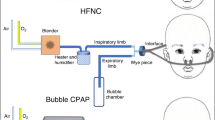Abstract
Background
Perinatal asphyxia is known to precipitate myocardial dysfunction, rhythm abnormalities and congestive cardiac failure.
Case characteristics
A 2-day old neonate with perinatal asphyxia.
Observation
He developed shock secondary to ventricular tachycardia, and required synchronized cardioversion for reversion of abnormal rhythm.
Outcome
Reversal of arrhythmia leading to recovery.
Message
Early identification and management of ventricular tachycardia in neonate with perinatal asphyxia can be lifesaving.
Similar content being viewed by others
References
Dubin. Arrhythmias in the newborn. Neoreviews. 2000;1:146–151.
Perlman JM, Tack ED, Martin T, Shackelford G, Amon E. Acute system organ injury in term infants after asphyxia. Am J Dis Child. 1989;143:617–620.
Tanel RE, Rhodes LA. Fetal and neonatal arrythmias. Clin Perinatology. 2001;28:187–207.
Poddar B, Basu S, Parmar V. Neonatal arrhythmias. Indian J Pediatr. 2006;73:131–134.
Singh D, Dutta S, Narang A. Hyperkalemia and ventricular tachycardia in an ELBW neonate. Indian Pediatr. 2003;40:64–66.
Virdi VS, Bharti B, Poddar B, Basu S. Ventricular tachycardia in congenital adrenal hyperplasia. Anesth Int Care. 2002;30:380–381.
Chelliah YR. Ventricular tachycardia associated with hypoglycaemia. Anesth Int Care. 2000;28:698–700.
Heinonen KM. Rare procedures during delivery room resuscitation-cardioversion of ventricular tachycardia in an asphyxiated neonate. Intensive Care Med. 1992;18:491–492.
TapiaRombo CA, AlvarezVazquez E, Mendoza Zanella RM, PerezOlea V, RosasFernandez C. Detection of transitory myocardial ischemia secondary to perinatal asphyxia. Arch Med Res. 2000;31:377–383.
Rajakumar PS, Vishnu Bhat B, Sridhar MG, Balachander J, Konar BC, Narayanan P, et al. Electrocardiographic and echocardiographic changes in perinatal asphyxia. Indian J Pediatr. 2009;76:261–264.
Author information
Authors and Affiliations
Corresponding author
Rights and permissions
About this article
Cite this article
Nirupam, N., Nangia, S. & Saili, A. Ventricular tachycardia due to perinatal asphyxia. Indian Pediatr 51, 227–228 (2014). https://doi.org/10.1007/s13312-014-0357-4
Received:
Revised:
Accepted:
Published:
Issue Date:
DOI: https://doi.org/10.1007/s13312-014-0357-4




